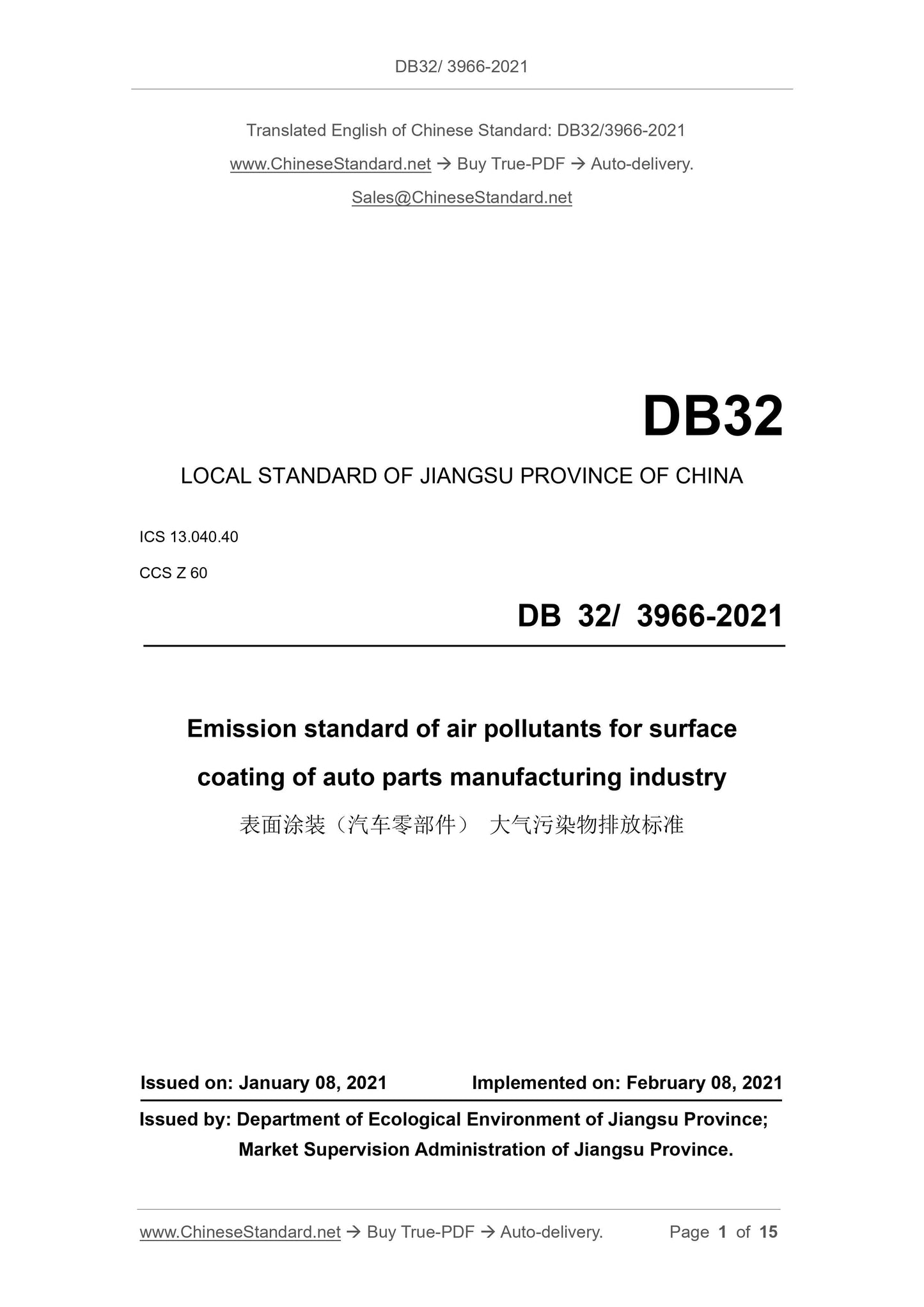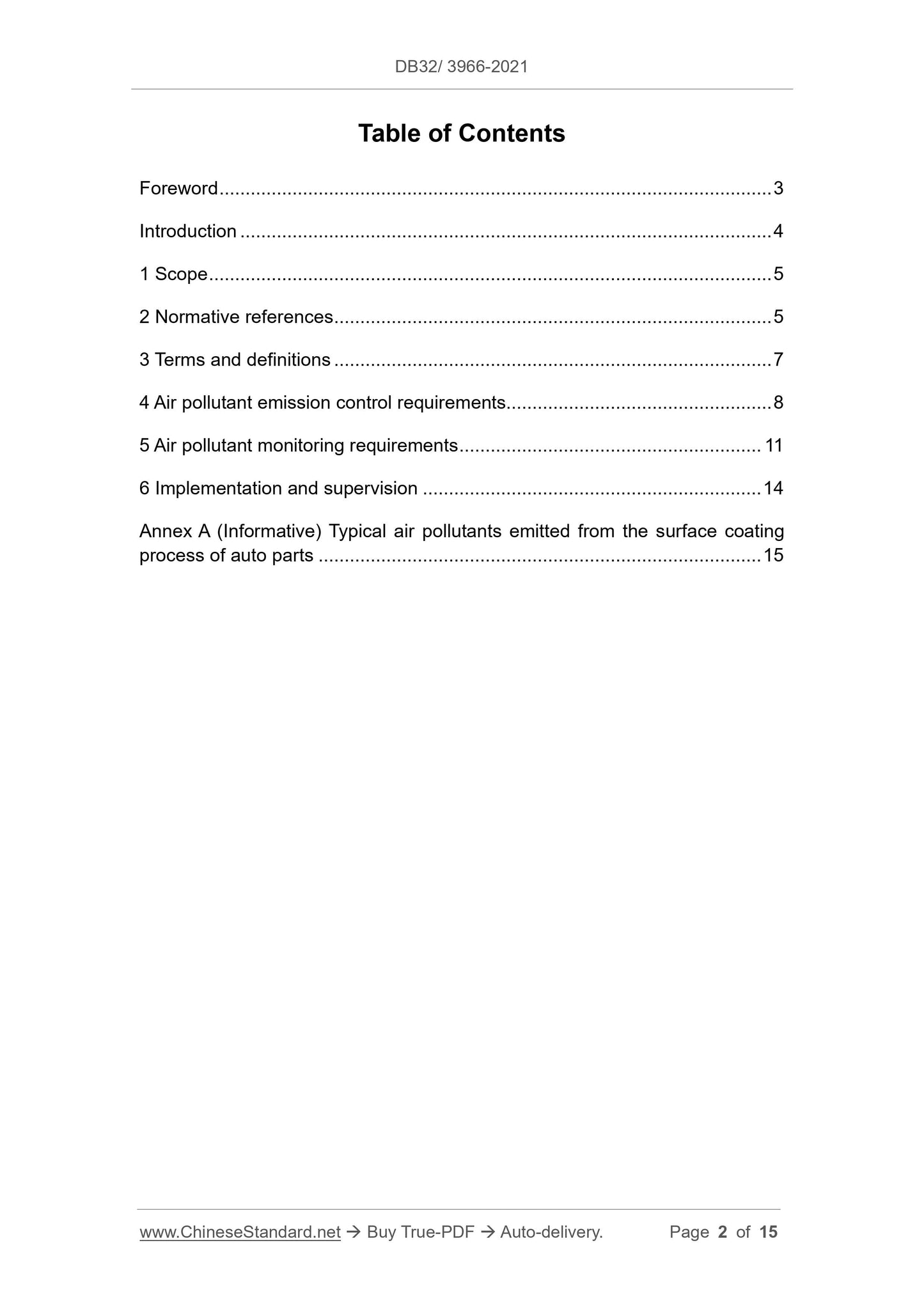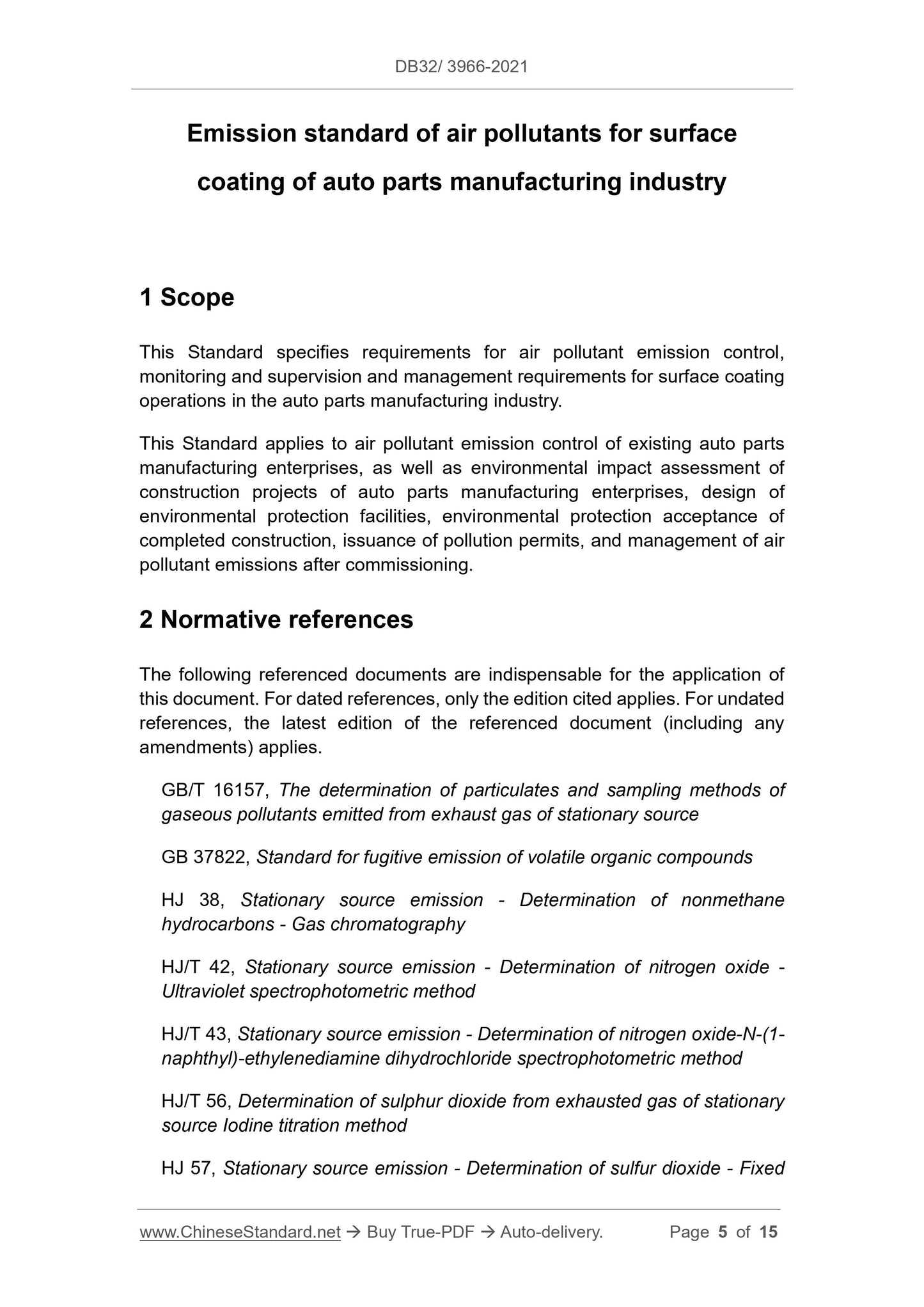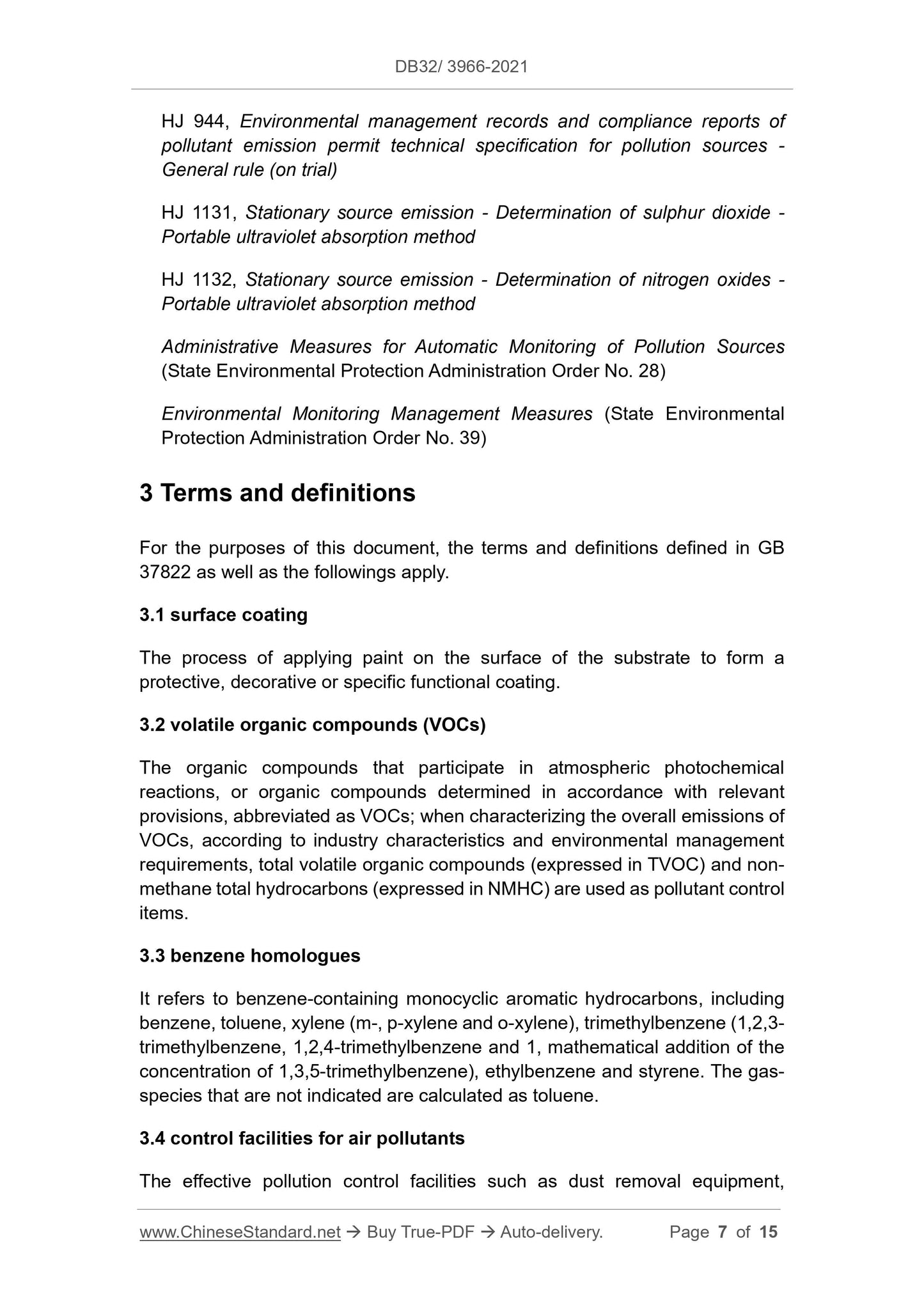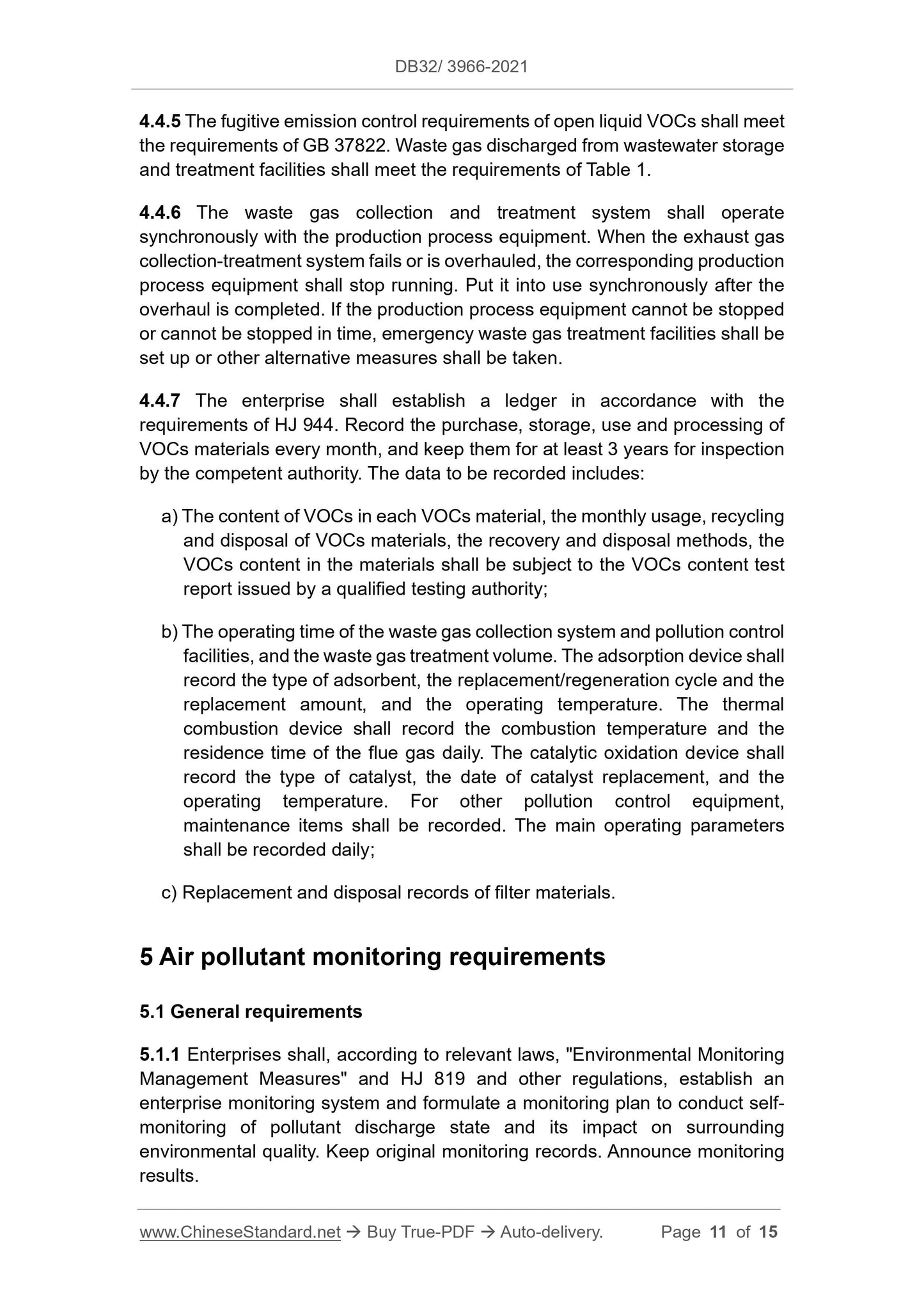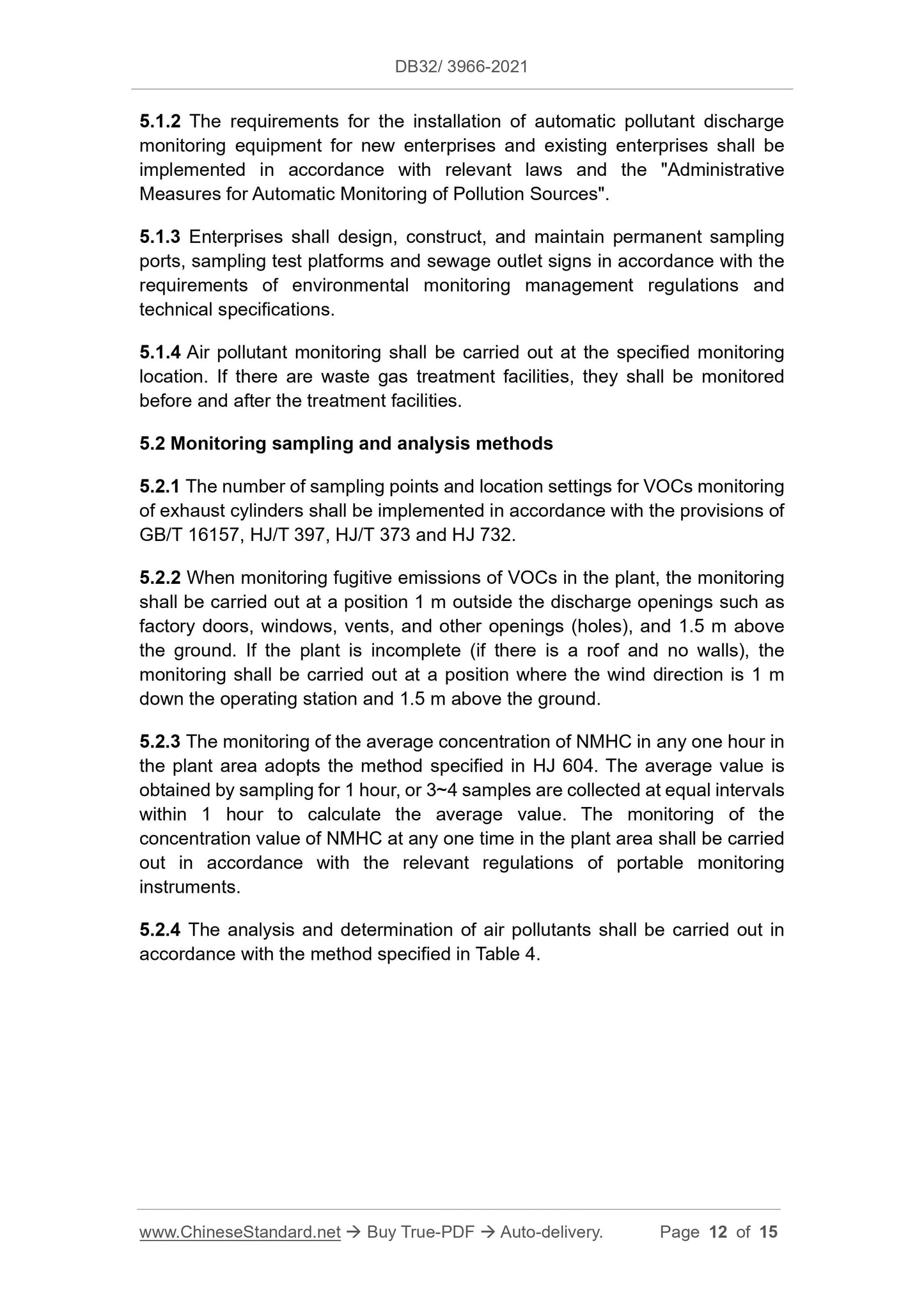1
/
の
6
PayPal, credit cards. Download editable-PDF and invoice in 1 second!
DB32/ 3966-2021 English PDF (DB323966-2021)
DB32/ 3966-2021 English PDF (DB323966-2021)
通常価格
$275.00 USD
通常価格
セール価格
$275.00 USD
単価
/
あたり
配送料はチェックアウト時に計算されます。
受取状況を読み込めませんでした
Delivery: 3 seconds. Download true-PDF + Invoice.
Get QUOTATION in 1-minute: Click DB32/ 3966-2021
Historical versions: DB32/ 3966-2021
Preview True-PDF (Reload/Scroll if blank)
DB32/ 3966-2021: Emission standard of air pollutants for surface coating of auto parts manufacturing industry
DB32/ 3966-2021
DB32
LOCAL STANDARD OF JIANGSU PROVINCE OF CHINA
ICS 13.040.40
CCS Z 60
DB 32/ 3966-2021
Emission standard of air pollutants for surface
coating of auto parts manufacturing industry
ISSUED ON: JANUARY 08, 2021
IMPLEMENTED ON: FEBRUARY 08, 2021
Issued by: Department of Ecological Environment of Jiangsu Province;
Market Supervision Administration of Jiangsu Province.
Table of Contents
Foreword ... 3
Introduction ... 4
1 Scope ... 5
2 Normative references ... 5
3 Terms and definitions ... 7
4 Air pollutant emission control requirements... 8
5 Air pollutant monitoring requirements ... 11
6 Implementation and supervision ... 14
Annex A (Informative) Typical air pollutants emitted from the surface coating
process of auto parts ... 15
Emission standard of air pollutants for surface
coating of auto parts manufacturing industry
1 Scope
This Standard specifies requirements for air pollutant emission control,
monitoring and supervision and management requirements for surface coating
operations in the auto parts manufacturing industry.
This Standard applies to air pollutant emission control of existing auto parts
manufacturing enterprises, as well as environmental impact assessment of
construction projects of auto parts manufacturing enterprises, design of
environmental protection facilities, environmental protection acceptance of
completed construction, issuance of pollution permits, and management of air
pollutant emissions after commissioning.
2 Normative references
The following referenced documents are indispensable for the application of
this document. For dated references, only the edition cited applies. For undated
references, the latest edition of the referenced document (including any
amendments) applies.
GB/T 16157, The determination of particulates and sampling methods of
gaseous pollutants emitted from exhaust gas of stationary source
GB 37822, Standard for fugitive emission of volatile organic compounds
HJ 38, Stationary source emission - Determination of nonmethane
hydrocarbons - Gas chromatography
HJ/T 42, Stationary source emission - Determination of nitrogen oxide -
Ultraviolet spectrophotometric method
HJ/T 43, Stationary source emission - Determination of nitrogen oxide-N-(1-
naphthyl)-ethylenediamine dihydrochloride spectrophotometric method
HJ/T 56, Determination of sulphur dioxide from exhausted gas of stationary
source Iodine titration method
HJ 57, Stationary source emission - Determination of sulfur dioxide - Fixed
HJ 944, Environmental management records and compliance reports of
pollutant emission permit technical specification for pollution sources -
General rule (on trial)
HJ 1131, Stationary source emission - Determination of sulphur dioxide -
Portable ultraviolet absorption method
HJ 1132, Stationary source emission - Determination of nitrogen oxides -
Portable ultraviolet absorption method
Administrative Measures for Automatic Monitoring of Pollution Sources
(State Environmental Protection Administration Order No. 28)
Environmental Monitoring Management Measures (State Environmental
Protection Administration Order No. 39)
3 Terms and definitions
For the purposes of this document, the terms and definitions defined in GB
37822 as well as the followings apply.
3.1 surface coating
The process of applying paint on the surface of the substrate to form a
protective, decorative or specific functional coating.
3.2 volatile organic compounds (VOCs)
The organic compounds that participate in atmospheric photochemical
reactions, or organic compounds determined in accordance with relevant
provisions, abbreviated as VOCs; when characterizing the overall emissions of
VOCs, according to industry characteristics and environmental management
requirements, total volatile organic compounds (expressed in TVOC) and non-
methane total hydrocarbons (expressed in NMHC) are used as pollutant control
items.
3.3 benzene homologues
It refers to benzene-containing monocyclic aromatic hydrocarbons, including
benzene, toluene, xylene (m-, p-xylene and o-xylene), trimethylbenzene (1,2,3-
trimethylbenzene, 1,2,4-trimethylbenzene and 1, mathematical addition of the
concentration of 1,3,5-trimethylbenzene), ethylbenzene and styrene. The gas-
species that are not indicated are calculated as toluene.
3.4 control facilities for air pollutants
The effective pollution control facilities such as dust removal equipment,
4.4.5 The fugitive emission control requirements of open liquid VOCs shall meet
the requirements of GB 37822. Waste gas discharged from wastewater storage
and treatment facilities shall meet the requirements of Table 1.
4.4.6 The waste gas collection and treatment system shall operate
synchronously with the production process equipment. When the exhaust gas
collection-treatment system fails or is overhauled, the corresponding production
process equipment shall stop running. Put it into use synchronously after the
overhaul is completed. If the production process equipment cannot be stopped
or cannot be stopped in time, emergency waste gas treatment facilities shall be
set up or other alternative measures shall be taken.
4.4.7 The enterprise shall establish a ledger in accordance with the
requirements of HJ 944. Record the purchase, storage, use and processing of
VOCs materials every month, and keep them for at least 3 years for inspection
by the competent authority. The data to be recorded includes:
a) The content of VOCs in each VOCs material, the monthly usage, recycling
and disposal of VOCs materials, the recovery and disposal methods, the
VOCs content in the materials shall be subject to the VOCs content test
report issued by a qualified testing authority;
b) The operating time of the waste gas collection system and pollution control
facilities, and the waste gas treatment volume. The adsorption device shall
record the type of adsorbent, the replacement/regeneration cycle and the
replacement amount, and the operating temperature. The thermal
combustion device shall record the combustion temperature and the
residence time of the flue gas daily. The catalytic oxidation device shall
record the type of catalyst, the date of catalyst replacement, and the
operating temperature. For other pollution control equipment,
maintenance items shall be recorded. The main operating parameters
shall be recorded daily;
c) Replacement and disposal records of filter materials.
5 Air pollutant monitoring requirements
5.1 General requirements
5.1.1 Enterprises shall, according to relevant laws, "Environmental Monitoring
Management Measures" and HJ 819 and other regulations, establish an
enterprise monitoring system and formulate a monitoring plan to conduct self-
monitoring of pollutant discharge state and its impact on surrounding
environmental quality. Keep original monitoring records. Announce monitoring
results.
5.1.2 The requirements for the installation of automatic pollutant discharge
monitoring equipment for new enterprises and existing enterprises shall be
implemented in accordance with relevant laws and the "Administrative
Measures for Automatic Monitoring of Pollution Sources".
5.1.3 Enterprises shall design, construct, and maintain permanent sampling
ports, sampling test platforms and sewage outlet signs in accordance with the
requirements of environmental monitoring management regulations and
technical sp...
Get QUOTATION in 1-minute: Click DB32/ 3966-2021
Historical versions: DB32/ 3966-2021
Preview True-PDF (Reload/Scroll if blank)
DB32/ 3966-2021: Emission standard of air pollutants for surface coating of auto parts manufacturing industry
DB32/ 3966-2021
DB32
LOCAL STANDARD OF JIANGSU PROVINCE OF CHINA
ICS 13.040.40
CCS Z 60
DB 32/ 3966-2021
Emission standard of air pollutants for surface
coating of auto parts manufacturing industry
ISSUED ON: JANUARY 08, 2021
IMPLEMENTED ON: FEBRUARY 08, 2021
Issued by: Department of Ecological Environment of Jiangsu Province;
Market Supervision Administration of Jiangsu Province.
Table of Contents
Foreword ... 3
Introduction ... 4
1 Scope ... 5
2 Normative references ... 5
3 Terms and definitions ... 7
4 Air pollutant emission control requirements... 8
5 Air pollutant monitoring requirements ... 11
6 Implementation and supervision ... 14
Annex A (Informative) Typical air pollutants emitted from the surface coating
process of auto parts ... 15
Emission standard of air pollutants for surface
coating of auto parts manufacturing industry
1 Scope
This Standard specifies requirements for air pollutant emission control,
monitoring and supervision and management requirements for surface coating
operations in the auto parts manufacturing industry.
This Standard applies to air pollutant emission control of existing auto parts
manufacturing enterprises, as well as environmental impact assessment of
construction projects of auto parts manufacturing enterprises, design of
environmental protection facilities, environmental protection acceptance of
completed construction, issuance of pollution permits, and management of air
pollutant emissions after commissioning.
2 Normative references
The following referenced documents are indispensable for the application of
this document. For dated references, only the edition cited applies. For undated
references, the latest edition of the referenced document (including any
amendments) applies.
GB/T 16157, The determination of particulates and sampling methods of
gaseous pollutants emitted from exhaust gas of stationary source
GB 37822, Standard for fugitive emission of volatile organic compounds
HJ 38, Stationary source emission - Determination of nonmethane
hydrocarbons - Gas chromatography
HJ/T 42, Stationary source emission - Determination of nitrogen oxide -
Ultraviolet spectrophotometric method
HJ/T 43, Stationary source emission - Determination of nitrogen oxide-N-(1-
naphthyl)-ethylenediamine dihydrochloride spectrophotometric method
HJ/T 56, Determination of sulphur dioxide from exhausted gas of stationary
source Iodine titration method
HJ 57, Stationary source emission - Determination of sulfur dioxide - Fixed
HJ 944, Environmental management records and compliance reports of
pollutant emission permit technical specification for pollution sources -
General rule (on trial)
HJ 1131, Stationary source emission - Determination of sulphur dioxide -
Portable ultraviolet absorption method
HJ 1132, Stationary source emission - Determination of nitrogen oxides -
Portable ultraviolet absorption method
Administrative Measures for Automatic Monitoring of Pollution Sources
(State Environmental Protection Administration Order No. 28)
Environmental Monitoring Management Measures (State Environmental
Protection Administration Order No. 39)
3 Terms and definitions
For the purposes of this document, the terms and definitions defined in GB
37822 as well as the followings apply.
3.1 surface coating
The process of applying paint on the surface of the substrate to form a
protective, decorative or specific functional coating.
3.2 volatile organic compounds (VOCs)
The organic compounds that participate in atmospheric photochemical
reactions, or organic compounds determined in accordance with relevant
provisions, abbreviated as VOCs; when characterizing the overall emissions of
VOCs, according to industry characteristics and environmental management
requirements, total volatile organic compounds (expressed in TVOC) and non-
methane total hydrocarbons (expressed in NMHC) are used as pollutant control
items.
3.3 benzene homologues
It refers to benzene-containing monocyclic aromatic hydrocarbons, including
benzene, toluene, xylene (m-, p-xylene and o-xylene), trimethylbenzene (1,2,3-
trimethylbenzene, 1,2,4-trimethylbenzene and 1, mathematical addition of the
concentration of 1,3,5-trimethylbenzene), ethylbenzene and styrene. The gas-
species that are not indicated are calculated as toluene.
3.4 control facilities for air pollutants
The effective pollution control facilities such as dust removal equipment,
4.4.5 The fugitive emission control requirements of open liquid VOCs shall meet
the requirements of GB 37822. Waste gas discharged from wastewater storage
and treatment facilities shall meet the requirements of Table 1.
4.4.6 The waste gas collection and treatment system shall operate
synchronously with the production process equipment. When the exhaust gas
collection-treatment system fails or is overhauled, the corresponding production
process equipment shall stop running. Put it into use synchronously after the
overhaul is completed. If the production process equipment cannot be stopped
or cannot be stopped in time, emergency waste gas treatment facilities shall be
set up or other alternative measures shall be taken.
4.4.7 The enterprise shall establish a ledger in accordance with the
requirements of HJ 944. Record the purchase, storage, use and processing of
VOCs materials every month, and keep them for at least 3 years for inspection
by the competent authority. The data to be recorded includes:
a) The content of VOCs in each VOCs material, the monthly usage, recycling
and disposal of VOCs materials, the recovery and disposal methods, the
VOCs content in the materials shall be subject to the VOCs content test
report issued by a qualified testing authority;
b) The operating time of the waste gas collection system and pollution control
facilities, and the waste gas treatment volume. The adsorption device shall
record the type of adsorbent, the replacement/regeneration cycle and the
replacement amount, and the operating temperature. The thermal
combustion device shall record the combustion temperature and the
residence time of the flue gas daily. The catalytic oxidation device shall
record the type of catalyst, the date of catalyst replacement, and the
operating temperature. For other pollution control equipment,
maintenance items shall be recorded. The main operating parameters
shall be recorded daily;
c) Replacement and disposal records of filter materials.
5 Air pollutant monitoring requirements
5.1 General requirements
5.1.1 Enterprises shall, according to relevant laws, "Environmental Monitoring
Management Measures" and HJ 819 and other regulations, establish an
enterprise monitoring system and formulate a monitoring plan to conduct self-
monitoring of pollutant discharge state and its impact on surrounding
environmental quality. Keep original monitoring records. Announce monitoring
results.
5.1.2 The requirements for the installation of automatic pollutant discharge
monitoring equipment for new enterprises and existing enterprises shall be
implemented in accordance with relevant laws and the "Administrative
Measures for Automatic Monitoring of Pollution Sources".
5.1.3 Enterprises shall design, construct, and maintain permanent sampling
ports, sampling test platforms and sewage outlet signs in accordance with the
requirements of environmental monitoring management regulations and
technical sp...
Share
